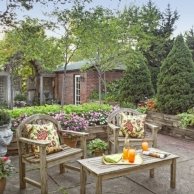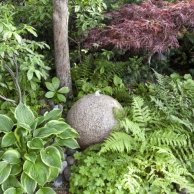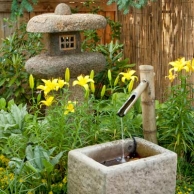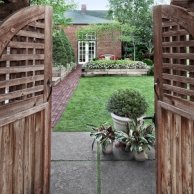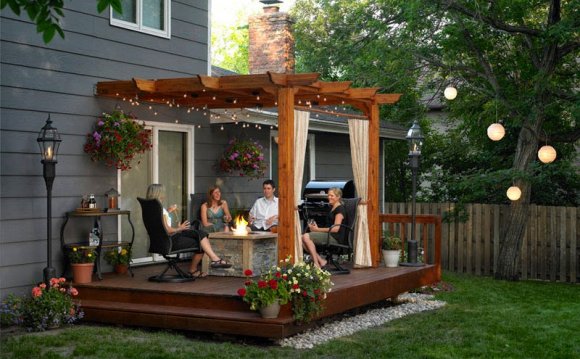
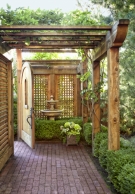 1 ×
1 ×
Landscaping Lessons
Mike Eagleton is often asked to conjure miracles from small, cheek-to-jowl city lots. The Denver landscape designer's own yard, around a 1929 brick cottage south of downtown, is a prime example of his professional sleight of hand. Within its 50 by 120 feet, he has incorporated sunny, street-side perennial beds, a private entry court in the rear, an elevated outdoor dining room, a secluded lounging terrace, a carpet of lawn, woodland views, a potting shed, and several destination strolls that lead to musical, spilling fountains. Front and back entrances, the latter marked by a wisteria arbor off the alley behind his property, make a garden walk of coming home. Almost year-round, despite his Zone 6 climate, with its frigid winters and baking summers, he's got something in bloom—in pots and borders and on top of arbors. Shade trees blot out neighbors' homes, and it's easy to forget, when he and his wife and their teenage kids kick back outside, that they're in a metropolis of 600, 000 people.
Shown: An arched wood gate to the left of the front entry opens onto a fountain that muffles street noise. The brick path leads from front yard to backyard.
2 ×
Organized Spaces
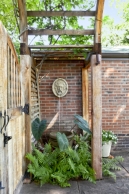
It wasn't so easy in 1989, when the couple bought the house, which sat wide open to its busy street with little more garden than a backyard deck and a patch of grass. Happily, there were a few mature trees, and Eagleton knew he could make his cramped lot feel larger with a well-conceived plan for hangout spots as well as play space for the kids. "Whether you like things formal or informal, " he says, "the mind wants organization. And when you create outdoor spaces that have a purpose, you use them." Gradually, the garden took the shape it has today, with gates and arbors marking passageways, sheltering trees and shrubs, and welcoming fountains. His landscaping lessons are sure to inspire any aspiring gardener with big hopes for a small space.
Shown: Just inside the gates, dramatic, large-leafed colocasia and ferns gather around a wall fountain that helps mute traffic noise from the back alley.
3 ×
Lesson 1: Create a Front-Yard Garden
Design a gracious garden setting out front to show off your house's best features and provide privacy. Eagleton matched the crisp lines of his vintage house with soft, English-style perennials that bloom against formal hedges. The hedges—dwarf burning bush, Euonymus alatus 'Compactus'—are much friendlier and less costly than masonry walls and, since they extend on both sides of the central steps, make the lot appear wider.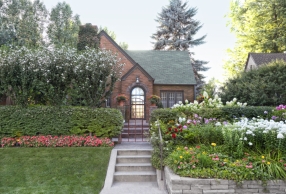 The low flagstone retaining wall he installed to edge his beds matches the home's warm brick facade, while the arched metal gate, once the frame of an old church window, echoes the arched front door. Tree-form rose of Sharon and limelight hydrangea, layered in between the clipped hedges, screen the front-entry court and create the illusion of greater depth from street to house.
The low flagstone retaining wall he installed to edge his beds matches the home's warm brick facade, while the arched metal gate, once the frame of an old church window, echoes the arched front door. Tree-form rose of Sharon and limelight hydrangea, layered in between the clipped hedges, screen the front-entry court and create the illusion of greater depth from street to house.
Shown: Garden designer Mike Eagleton layered his home's street-facing landscape for beauty and privacy.
4 ×
Lesson 2: Go Big with Hardscape
Don't try to maximize space by undersizing steps and walkways; paths should be at least 4 feet across, says Eagleton. Skimpy paved areas look out of scale with your house—even modest homes present a large structure to work against—and they will shrink further once plants grow in around them. Eagleton widened the existing steps and landings in his entry court and replaced the original dark brown concrete with colored, patterned concrete that mimics the flagstone of his retaining wall and ties the garden more fully to the house.
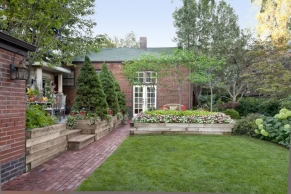 Shown: The backyard's brick path, a straight shot from rear gate to kitchen doors, separates the lawn and lounge from the dining deck.
Shown: The backyard's brick path, a straight shot from rear gate to kitchen doors, separates the lawn and lounge from the dining deck.
5 ×
Lesson 3: Blur Your Lot's Boundaries
Borrow from your neighbors by forgoing unnecessary side fences that call attention to your lot's limits. Thanks to his unfenced front yard, Eagleton's lavish perennials merge with a flood of junipers next door, hinting that both belong to one landscape. The same trick works with trees, he says, so make sure the ones you plant don't block those visible on other properties. As you look out beyond your own branches, especially if they resemble others nearby, they'll all seem part of the same expansive picture.
Shown: A bristlecone pine and a blue spruce screen the cedar dining deck. Containers filled with summer annuals—marigolds, petunias, impatiens, and vining mandevilla—soften the corner near the potting shed, bringing colorful blossoms close enough for guests to enjoy.
6 ×
Lesson 4: Carve Out Outdoor Rooms
Break up large outdoor spaces into smaller areas. Your garden feels bigger if you can't see all its "rooms" at once, an effect Eagleton achieved through slight grade changes, walled enclosures, and plant screens. The original backyard was mostly lawn with maple, hawthorn, and spruce trees along the edges, and a cramped wood deck. Over time, he replaced the deck with a raised one 8 feet larger and framed it with landscape-tie planters 2 feet higher than the garden below. These planters surround the dining spot with close-up blooms and selectively block larger garden views with dwarf Alberta spruces. He left a piece of lawn for his children, but at one end, between it and the kitchen door, he designed an outdoor lounge area, screened with another planter—this one 18 inches high and 12 feet long—filled with tree-form serviceberry shrubs and billowing coleus and impatiens.
Shown: A lounge area is tucked between the elevated dining deck—screened with conical dwarf Alberta spruces—and a planter in which serviceberry trees mix with coleus and pink and white impatiens.
